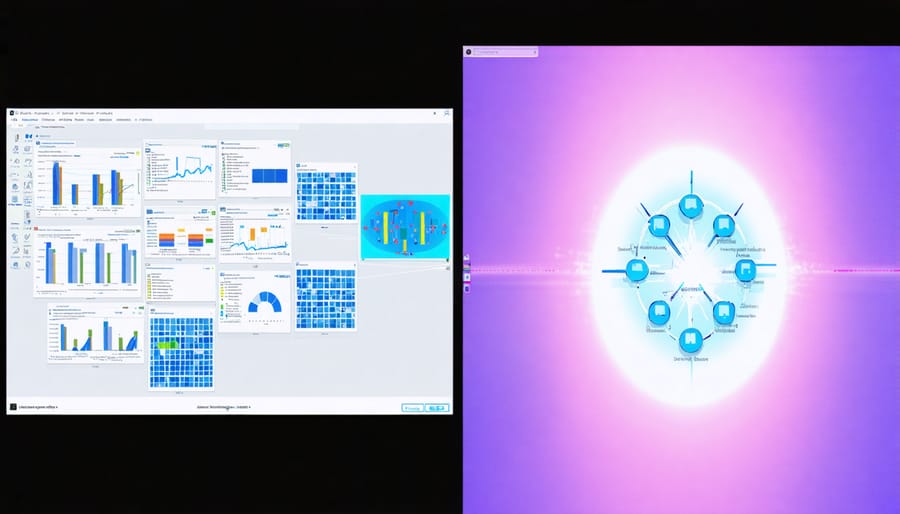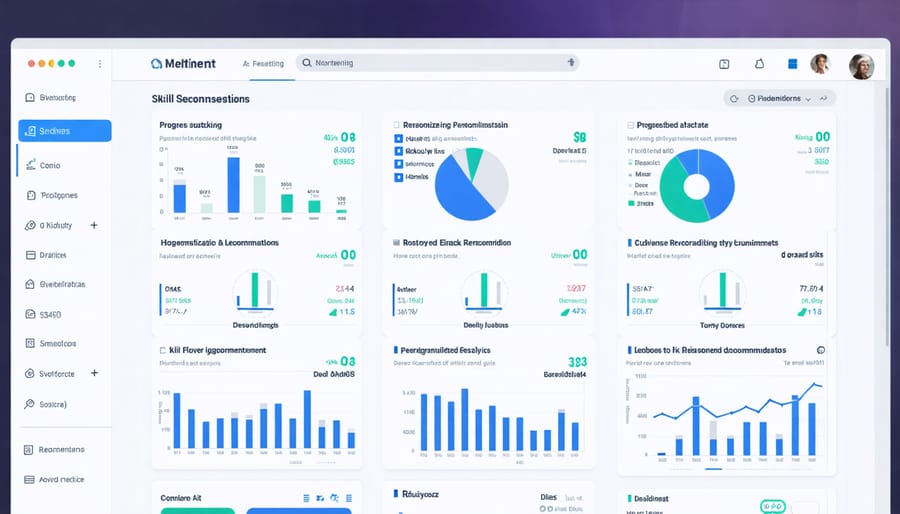In today’s interconnected world, AI is transforming education and workplace collaboration at an unprecedented pace. Collaborative AI represents the next evolution in human-machine partnership, where artificial intelligence doesn’t just automate tasks but actively enhances team dynamics, decision-making, and creative problem-solving.
Unlike traditional AI systems that operate in isolation, collaborative AI platforms work alongside human teams, adapting to individual working styles while fostering meaningful interactions between team members. These systems analyze patterns in group behavior, facilitate real-time knowledge sharing, and provide intelligent suggestions that amplify collective intelligence rather than replace it.
The impact extends beyond simple productivity gains. From virtual assistants that coordinate complex project workflows to AI-powered brainstorming tools that help teams overcome creative blocks, collaborative AI is reshaping how we think about teamwork in the digital age. As organizations increasingly embrace hybrid work environments, these technologies are becoming essential bridges that connect distributed teams and enable seamless cooperation across time zones and cultural boundaries.
This transformative approach to AI integration marks a shift from viewing artificial intelligence as a replacement for human workers to seeing it as an empowering force that enhances human capabilities and promotes more effective collaboration.

The Power of AI-Driven Collaborative Learning
Real-time Adaptive Learning
In collaborative AI environments, real-time adaptive learning represents a groundbreaking approach to team-based education. Unlike traditional interactive online learning platforms, these systems continuously analyze team performance and adjust both content difficulty and learning paths dynamically.
Think of it as having an intelligent tutor that observes how your team solves problems together. When the system notices that certain team members struggle with specific concepts, it automatically provides additional resources or simplifies the material. Conversely, if the team demonstrates mastery, the AI increases the challenge level to maintain engagement and promote growth.
The adaptation happens across multiple dimensions: content complexity, pace of delivery, collaboration requirements, and even the format of learning materials. For instance, if a team excels at visual problem-solving but struggles with text-based exercises, the AI might shift to present more diagram-based challenges while gradually introducing textual elements to build comprehensive skills.
This dynamic adjustment ensures that teams remain in their optimal learning zone, neither overwhelmed nor under-challenged, leading to more effective and engaging collaborative learning experiences.
Intelligent Group Formation
In modern collaborative learning environments, AI algorithms revolutionize how groups are formed by analyzing multiple factors beyond traditional manual matching. These intelligent systems process data about learners’ academic performance, communication styles, personality traits, and skill levels to create balanced and effective teams.
The AI examines learning patterns and preferences, such as whether students perform better with visual aids or hands-on exercises, and matches complementary styles together. It also considers past collaboration history, time zone availability, and language proficiency to ensure smooth team dynamics.
What makes this approach particularly powerful is its ability to adapt in real-time. As learners progress and develop new skills, the AI continuously updates its grouping recommendations. For example, if a student shows improvement in leadership skills, the system might place them with peers who could benefit from mentorship.
This data-driven approach has shown remarkable results, with studies indicating up to 30% improvement in team performance compared to random grouping. Organizations implementing AI-powered group formation report higher engagement levels, better knowledge sharing, and more balanced participation among team members.
Key Features of Modern AI Learning Platforms
Smart Content Recommendations
In modern collaborative learning environments, AI-powered content recommendations act as a personalized learning guide for each team member. These smart systems analyze individual learning patterns, comprehension levels, and interaction history to curate tailored educational materials that optimize the learning experience.
The AI accomplishes this by tracking several key indicators: time spent on different topics, completion rates, assessment scores, and even the types of questions asked during learning sessions. For example, if a team member excels in data visualization but struggles with statistical concepts, the AI will automatically adjust to provide more foundational statistics content while offering advanced visualization challenges.
What makes these recommendations particularly powerful is their ability to evolve with the team’s collective progress. When multiple team members show similar learning patterns or challenges, the AI can suggest group learning activities or shared resources that address common needs. This creates a more cohesive learning experience while maintaining personalization.
The system also considers the team’s project goals and deadlines. If a team is working on implementing a new machine learning model, the AI will prioritize content related to that specific technology, ensuring that learning directly supports practical objectives. This smart content curation helps teams stay focused on relevant materials while building complementary skills across the group.
Real-time adjustments ensure that recommendations remain current and effective, creating a dynamic learning environment that adapts to both individual and team needs.
Progress Tracking and Analytics
In today’s data-driven learning environments, collaborative AI systems excel at providing detailed insights into how teams learn and grow together. These intelligent systems can measure tech skills and track progress with unprecedented accuracy, offering real-time feedback that helps both learners and instructors optimize their approach.
AI-powered analytics tools monitor various metrics, including participation rates, response times, and knowledge retention across team members. By analyzing interaction patterns and learning behaviors, these systems can identify areas where teams excel and pinpoint opportunities for improvement. This data-driven approach enables personalized learning paths while maintaining group cohesion and shared goals.
The real power of collaborative AI analytics lies in its ability to predict learning outcomes and suggest interventions before challenges become obstacles. For instance, if the system detects that certain team members are struggling with specific concepts, it can automatically recommend additional resources or adjust the difficulty level of upcoming exercises.
Visual dashboards and progress reports make it easy for teams to track their collective journey, celebrate milestones, and maintain motivation. These tools also help instructors make informed decisions about curriculum adjustments and provide targeted support where it’s needed most, ensuring that no team member falls behind while fostering a supportive learning environment.

Implementation Strategies
Platform Selection Criteria
When selecting a collaborative AI learning platform, several critical factors should guide your decision. First, consider the platform’s user interface and accessibility – it should be intuitive enough for team members with varying technical backgrounds to use effectively. The learning curve shouldn’t be so steep that it becomes a barrier to adoption.
Integration capabilities are equally important. The platform should seamlessly connect with your existing tools and workflows, whether that’s project management software, communication tools, or data analysis systems. This ensures minimal disruption to your team’s established processes.
Security and privacy features are non-negotiable. Look for platforms with robust data protection measures, especially when handling sensitive information. This includes encryption, access controls, and compliance with relevant industry standards.
Scalability is another crucial factor. The platform should grow with your team, handling increased user loads and data volumes without performance issues. Consider both current needs and future expansion plans.
Also evaluate the platform’s collaborative features, such as real-time editing, feedback mechanisms, and version control. These features should facilitate natural interaction and knowledge sharing among team members.
Finally, assess the platform’s AI capabilities, including machine learning algorithms, natural language processing, and automated workflow features. These should align with your specific learning objectives and use cases.
Integration Best Practices
To successfully implement collaborative AI in your organization, start by establishing clear objectives and success metrics. Begin with a pilot program in a small team, allowing for adjustments and feedback before scaling up. Ensure all team members receive proper training and understand how the AI tools complement their existing workflow rather than replace it.
Create detailed documentation and guidelines that outline best practices, including data privacy protocols and ethical considerations. Set up regular check-ins to address concerns and share success stories, building confidence in the new system. Consider appointing AI champions within teams to provide peer support and encourage adoption.
Focus on transparency by clearly communicating how the AI makes decisions and where human oversight is maintained. Implement a feedback loop system where team members can report issues and suggest improvements. This collaborative approach helps build trust and ensures the technology serves your team’s specific needs.
Remember to regularly evaluate and update your integration strategy based on performance metrics and team feedback. Start with basic features and gradually introduce more advanced capabilities as your team becomes more comfortable with the technology. This measured approach helps prevent overwhelming users while maintaining steady progress toward full adoption.
Finally, celebrate small wins and recognize team members who effectively leverage the AI tools, creating a positive culture around technological advancement.

Future Trends and Innovations
The future of collaborative AI in learning platforms is rapidly evolving, with several groundbreaking developments on the horizon. One of the most promising trends is the integration of visual learning AI systems that can adapt to different learning styles and preferences, making complex topics more accessible to diverse groups of learners.
Personalized learning paths powered by AI are becoming increasingly sophisticated, with systems that can predict and adjust to each team member’s progress and challenges in real-time. These adaptive platforms use machine learning algorithms to create custom content recommendations and learning sequences based on collective team performance and individual needs.
Natural language processing is advancing to enable more nuanced and context-aware interactions between learners and AI systems. Future platforms will feature improved sentiment analysis capabilities, allowing them to better understand and respond to learners’ emotional states and engagement levels during collaborative sessions.
Emerging technologies like augmented reality (AR) and virtual reality (VR) are being integrated into collaborative AI platforms, creating immersive learning environments where teams can work together regardless of physical location. These environments will enable hands-on practice and experimentation in safe, controlled settings.
The integration of blockchain technology is also gaining traction, offering new possibilities for verifying and tracking learning achievements across organizations. This development will make it easier for teams to maintain transparent records of their collective knowledge and skills development while ensuring the security and integrity of learning data.
Looking ahead, we can expect to see more emphasis on ethical AI practices in collaborative learning, with built-in safeguards to protect user privacy and ensure fair, unbiased learning experiences for all participants.
As we look to the future, collaborative AI is revolutionizing how we learn and work together on digital platforms. The integration of AI-powered tools has transformed traditional learning environments into dynamic, interactive spaces where students and professionals can engage in real-time collaboration, receive personalized feedback, and benefit from adaptive learning paths.
The impact of collaborative AI extends beyond simple automation. It’s creating more inclusive learning environments, breaking down geographical barriers, and enabling 24/7 access to educational resources. These systems are becoming increasingly sophisticated, using natural language processing and machine learning to understand user needs better and facilitate more meaningful interactions among learners.
Looking ahead, we can expect to see even more advanced applications of collaborative AI in learning platforms. From AI-powered virtual study groups to intelligent content curation and automated mentoring systems, the possibilities are expanding rapidly. As these technologies continue to evolve, they will likely become more intuitive and accessible, making collaborative learning more effective and engaging for users worldwide.
The future of collaborative AI in learning platforms points toward a more connected, personalized, and efficient educational ecosystem that adapts to individual learning styles while fostering meaningful collaboration among users.

